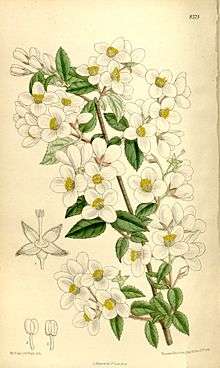Philadelphus delavayi
| Philadephus delavayi | |
|---|---|
 | |
| Scientific classification | |
| Kingdom: | Plantae |
| (unranked): | Angiosperms |
| (unranked): | Eudicots |
| (unranked): | Asterids |
| Order: | Cornales |
| Family: | Hydrangeaceae |
| Genus: | Philadelphus |
| Species: | P. delavayi |
| Binomial name | |
| Philadelphus delavayi | |
Philadelphus delavayi is a deciduous shrub in the genus Philadelphus, native to China, Tibet, and Upper Burma. It was discovered by Pierre Jean Marie Delavay in 1887. It has an upright growth habit, to a height of 3 metres, with arching branches and ovate, tapered, sometimes toothed, dark green leaves up to 10 cm or more long. It bears racemes of 5-9 cup shaped, single, very fragrant creamy-white flowers, 2.5 cm across.
References
- The Hillier Manual of Trees and Shrubs, Ed. John Hillier, David & Charles 2007, ISBN 978-0-7153-2664-0
- The Royal Horticultural Society A-Z Encyclopaedia of Garden Plants, Ed. Christopher Bickell, Dorling Kindersley 1996, ISBN 0-7513-0303-8
This article is issued from Wikipedia - version of the 2/11/2016. The text is available under the Creative Commons Attribution/Share Alike but additional terms may apply for the media files.